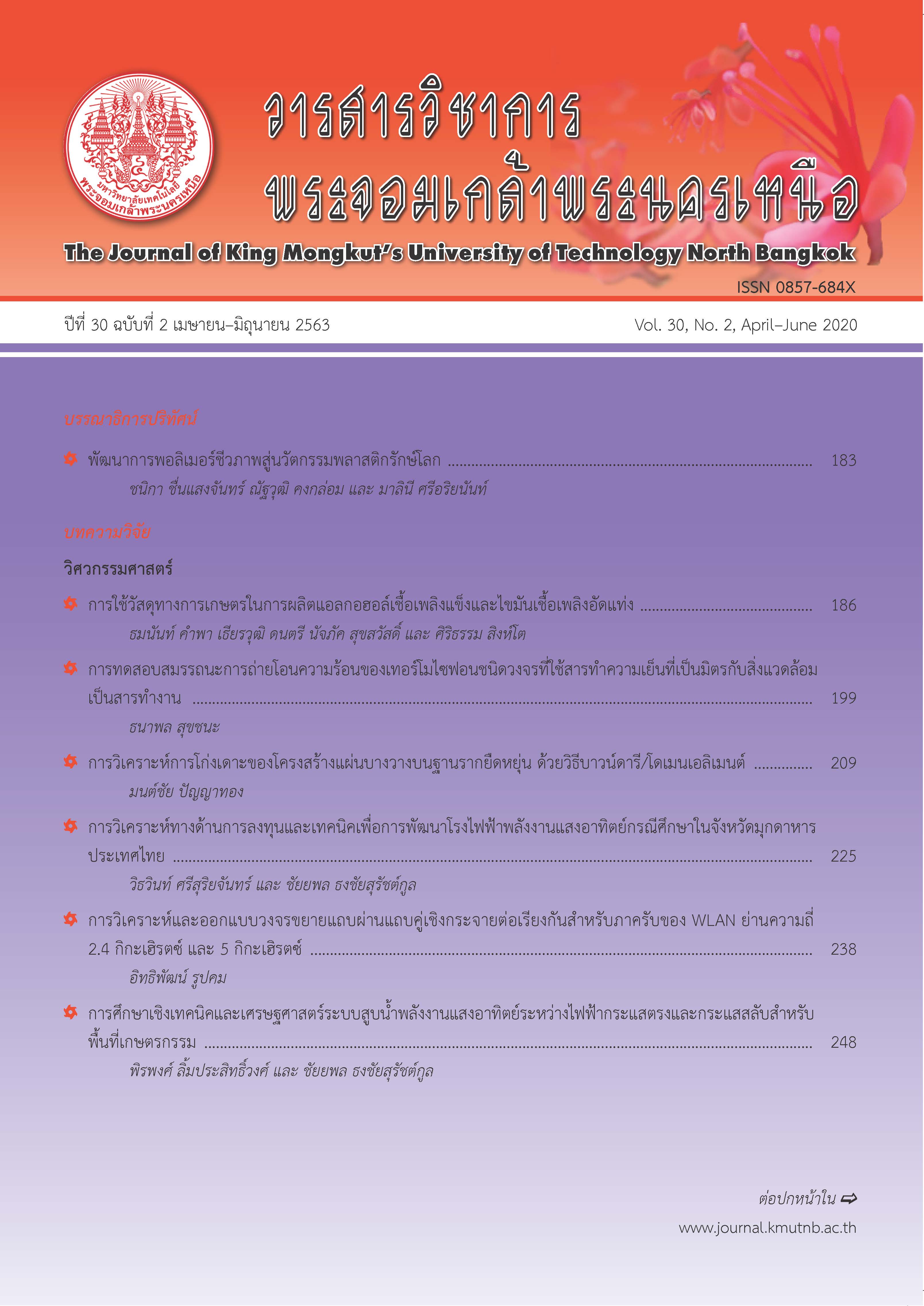การออกแบบอีเจ็คเตอร์และประเมินค่าสัมประสิทธิ์สมรรถนะสำหรับระบบทำความเย็นที่ใช้อีเจ็คเตอร์เป็นอุปกรณ์ขยาย
Main Article Content
บทคัดย่อ
งานวิจัยนี้มีจุดประสงค์เพื่อออกแบบอีเจ็คเตอร์แบบสองสถานะและประเมินสัมประสิทธิ์สมรรถนะ (COP) การทำความเย็นของระบบทำความเย็นที่ใช้อีเจ็คเตอร์เป็นอุปกรณ์ขยาย สมการทางคณิตศาสตร์ถูกใช้วิเคราะห์ความสัมพันธ์ระหว่างสภาวะการทำงานกับขนาดของอีเจ็คเตอร์ และ COP ของระบบ ตามลำดับ ในการศึกษานี้ ระบบทำความเย็นมีวิสัยสามารถการทำความเย็น 3.5 กิโลวัตต์ เครื่องควบแน่นและเครื่องระเหยทำงานในช่วงอุณหภูมิ 35–55 องศาเซลเซียส และ 0–15 องศาเซลเซียส ตามลำดับ และใช้ R32 เป็นสารทำงาน จากผลการศึกษาแสดงให้เห็นว่าสภาวะการทำงานที่เปลี่ยนแปลงส่งผลกระทบต่อขนาดของอีเจ็คเตอร์และ COP ของระบบเป็นอย่างมาก นอกจากนี้ ความสัมพันธ์ที่ได้รับจากการศึกษานี้สามารถใช้เป็นแนวทางในการออกแบบระบบทำความเย็นที่ใช้เป็นอุปกรณ์ขยายได้อีกด้วย
Article Details
บทความที่ลงตีพิมพ์เป็นข้อคิดเห็นของผู้เขียนเท่านั้น
ผู้เขียนจะต้องเป็นผู้รับผิดชอบต่อผลทางกฎหมายใดๆ ที่อาจเกิดขึ้นจากบทความนั้น
เอกสารอ้างอิง
[2] H. Nasution and W. N. M. Hasan, “Potential electricity savings by variable speed control of compressor for air conditioning systems,” Clean Technologies and Environmental Policy, vol. 8, no. 2, pp. 105–1011, 2006.
[3] C. Aprea, R. Mastrullo, and C. Renno, “Experimental analysis of the scroll compressor performances varying its speed,” Applied Thermal Engineering, vol. 26, no.10, pp. 983–992, 2006.
[4] T. Q. Qureshi and S. A. Tassau, “Variable- speed capacity control in refrigeration system,” Applied Thermal Engineering, vol. 16, no.2, pp. 103–113, 1996.
[5] A. A. Kornhauser, “The use of an ejector as a refrigerant expander,” in Proceedings of the USN/IIR-Purdue refrigeration conference, USA, pp. 10–19, 1990.
[6] E. Nehdi, L. Kairouani, and M. Bouzaina, “Performance analysis of the vapor compression cycle using ejector as an expander,” International Journal Energy Research, vol. 31, no. 4, pp. 364–75, 2007.
[7] N. Billir and H. K. Ersoy, “Performance improvement of the vapour compression refrigeration cycle by a two-phase constant area ejector,” International Journal of Energy Research, vol. 33, no.5, pp. 469–480, 2009.
[8] H. K. Ersoy and N. B. Sag, “Preliminary experimental results on the R134a refrigeration system using a two-phase ejector as an expander,” International Journal of Refrigeration, vol. 43, pp. 97–110, 2014.
[9] M. Hassanain, E. Elgendy, and M. Fatouh, “Ejector expansion refrigeration system: Ejector design and performance evaluation,” International Journal of Refrigeration, vol. 58, pp. 1–13, 2015.
[10] N. B. Sag and H. K. Ersoy, “Experimental investigation on motive nozzle throat diameter for an ejector expansion refrigeration system,” Energy Conversation and Management, vol. 124, pp. 1–12, 2016.
[11] Y. Li and J. Yu, “The effects of ejector geometry parameter and refrigerant charge amount on an ejector-expansion refrigeration system,” Applied Thermal Engineering, vol. 152, pp. 402–408, 2019.
[12] P. Chaiwongsa, “Effect of geometric parameters of ejector on the performance of refrigeration cycle using ejector as an expansion device,” M.S. thesis, Department of Mechanical Engineering, Faculty of Engineering King Mongkut’s University of Technology Thonburi, Bangkok, Thailand, 2005 (in Thai).
[13] O. Brunin, M. Feidt, and B. Hivet, “Comparison of the working domains of some compression heat pumps and a compression-absorption heat pump,” International Journal of Refrigeration, vol. 20, no. 5, pp. 308–318, 1997.
[14] R. Yapici and H. K. Ersoy, “Performance characteristics of the ejector refrigeration system based on the constant area ejector flow model,” Energy Conversion and Management, vol. 46, pp. 3117–3135, 2005.
[15] C. lin, C. Xu, B. Yue, C. Jiang, H. Omori, and J. Deng, “Experimental study on the separator in ejectorexpansion refrigeration system,” International Journal of Refrigeration, vol. 100, pp. 307–314, 2019.

